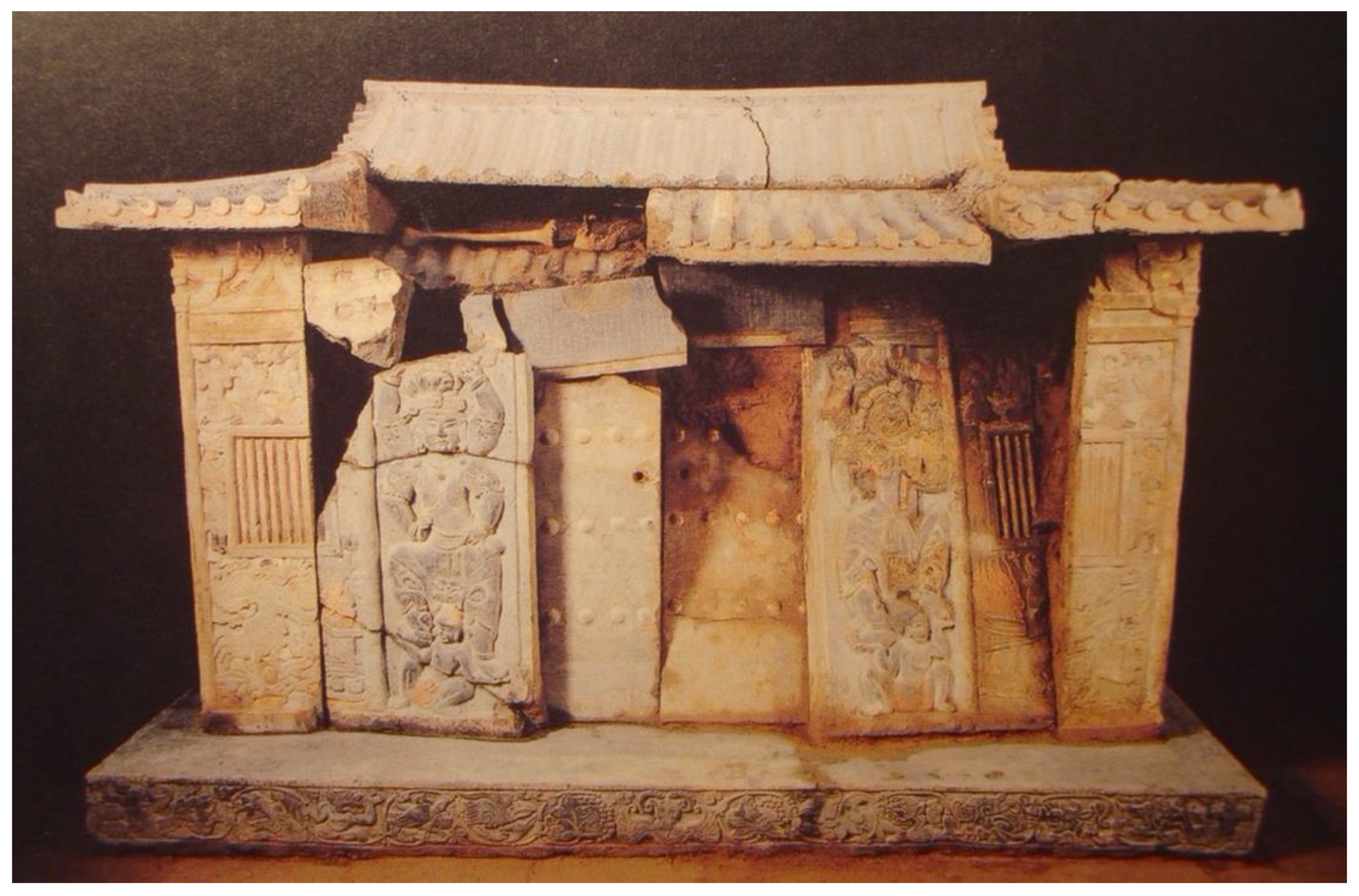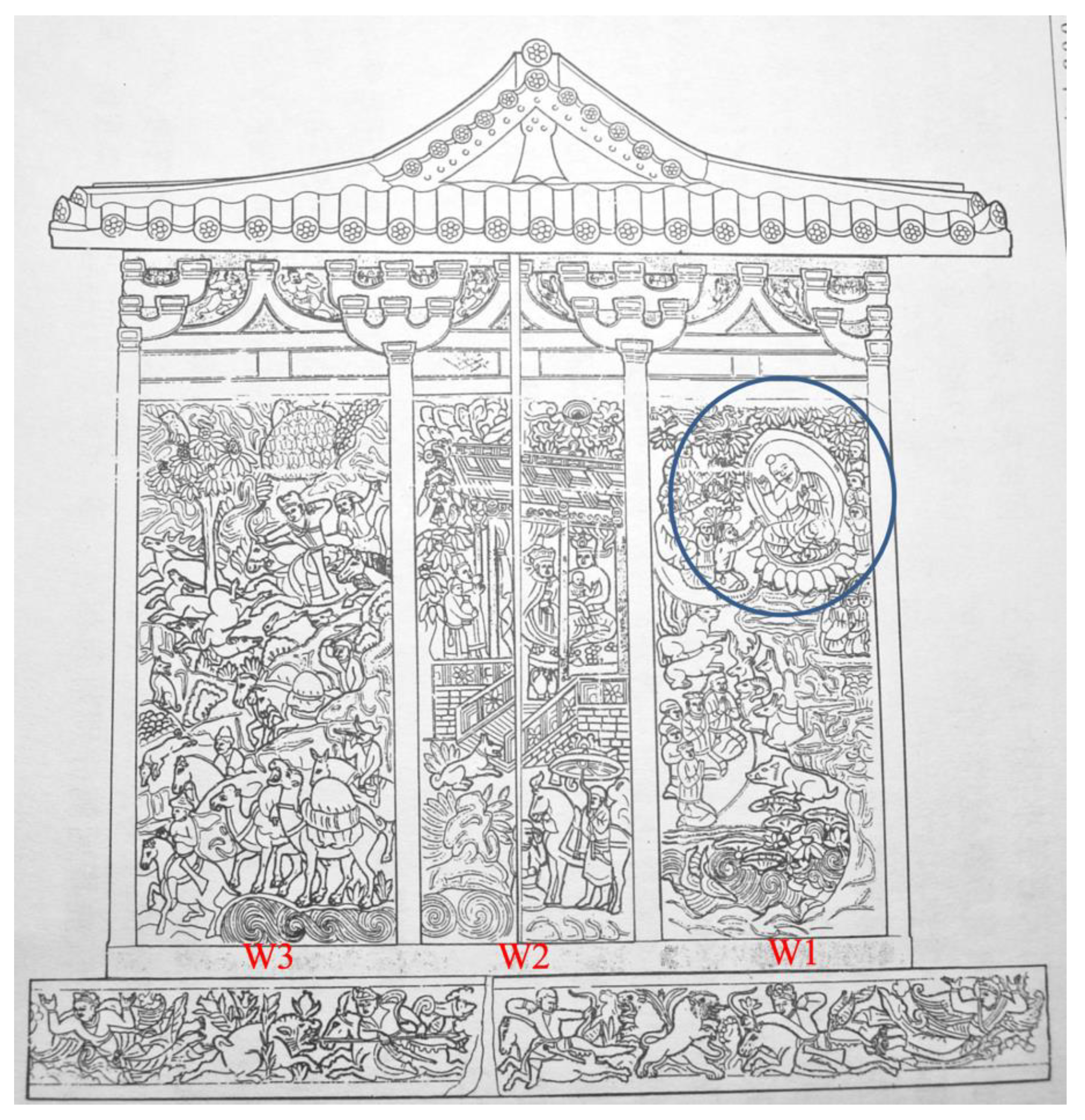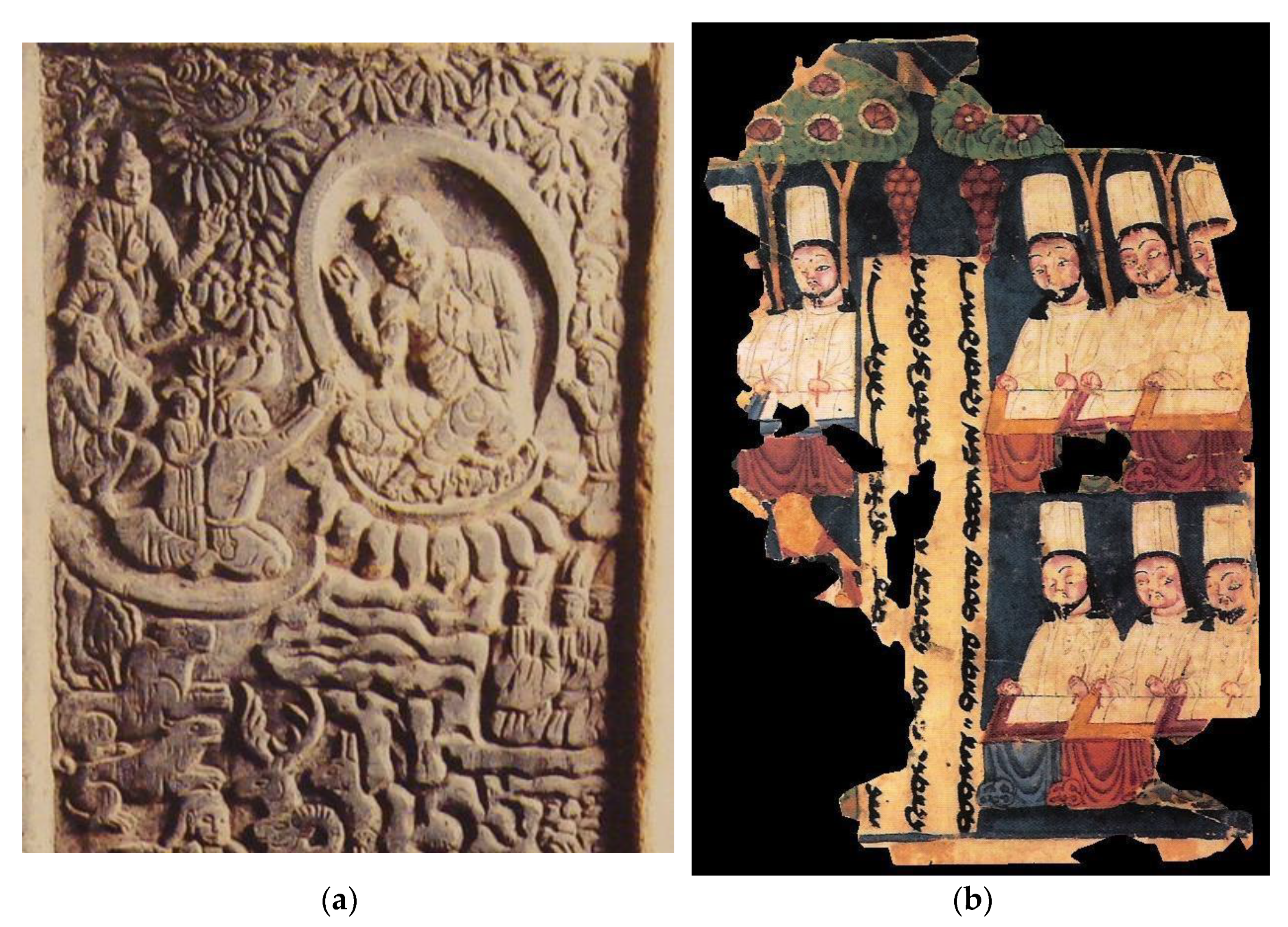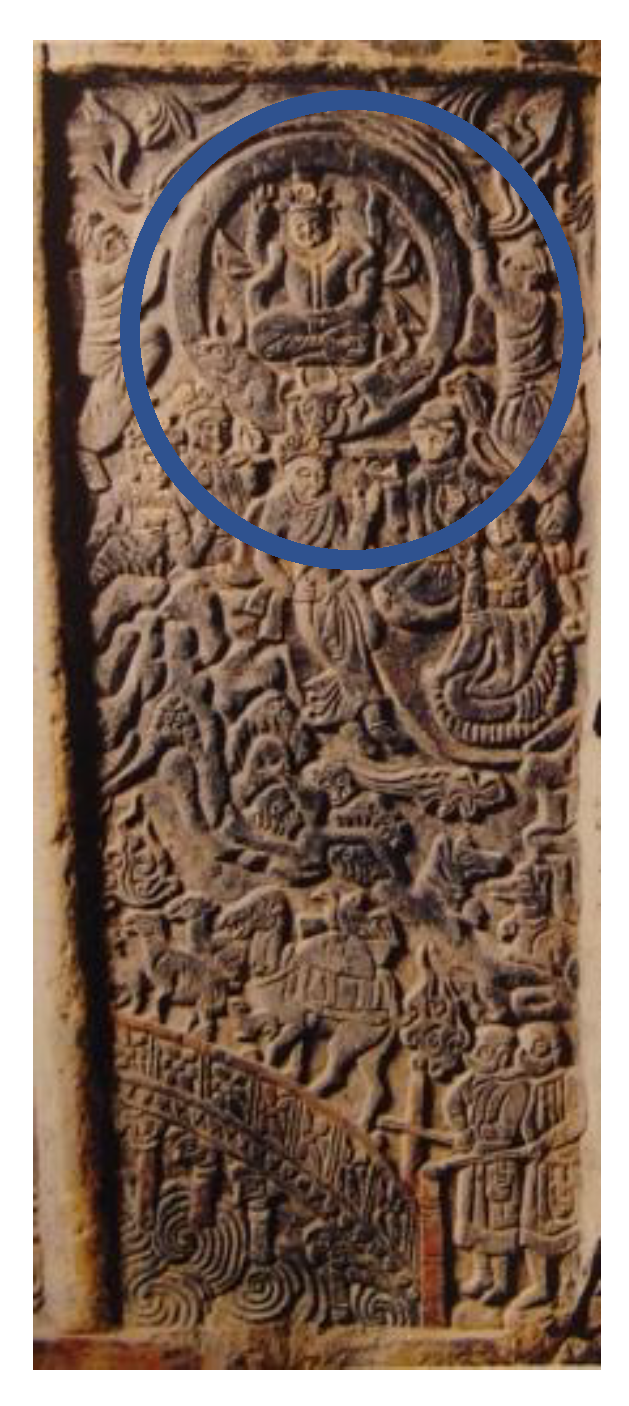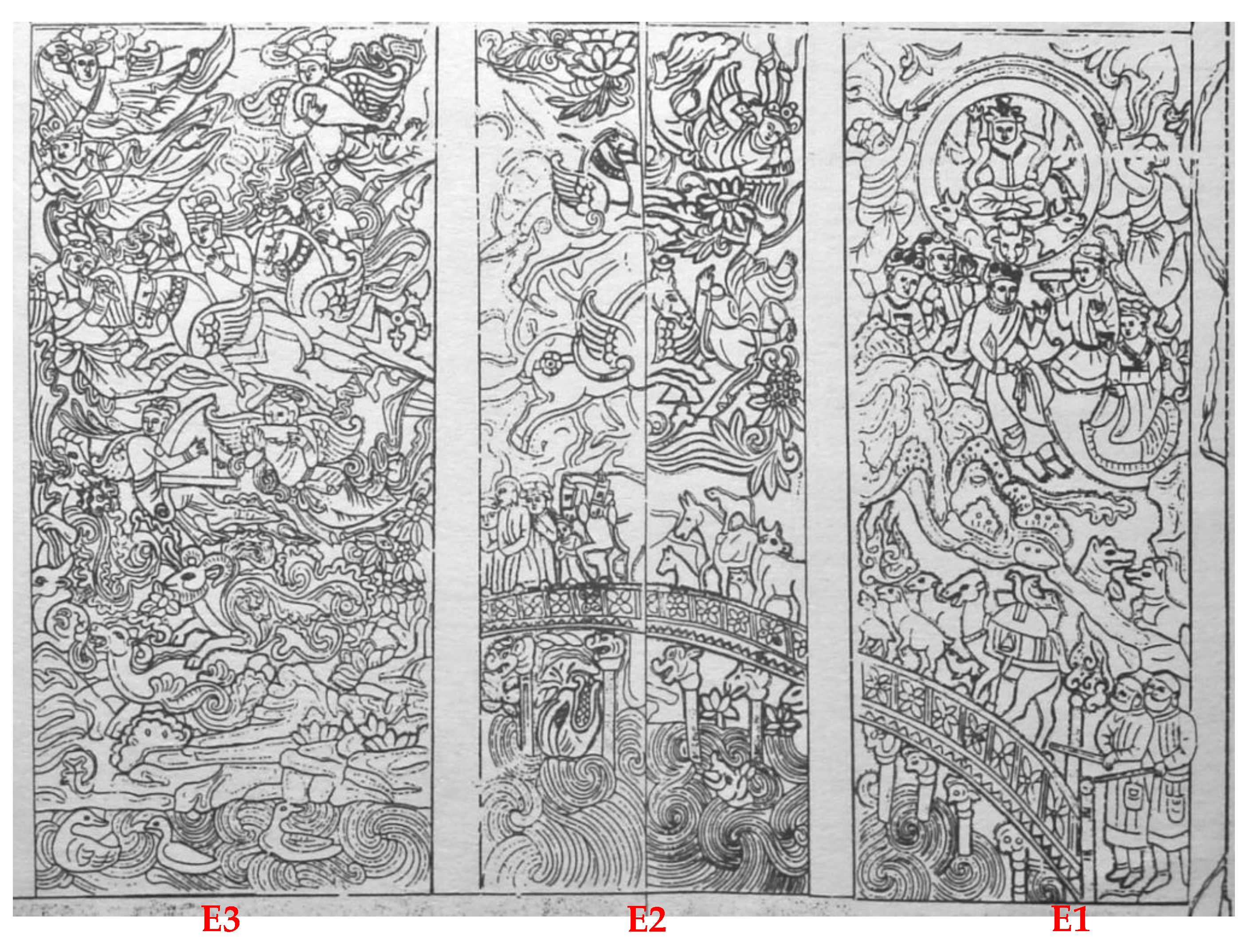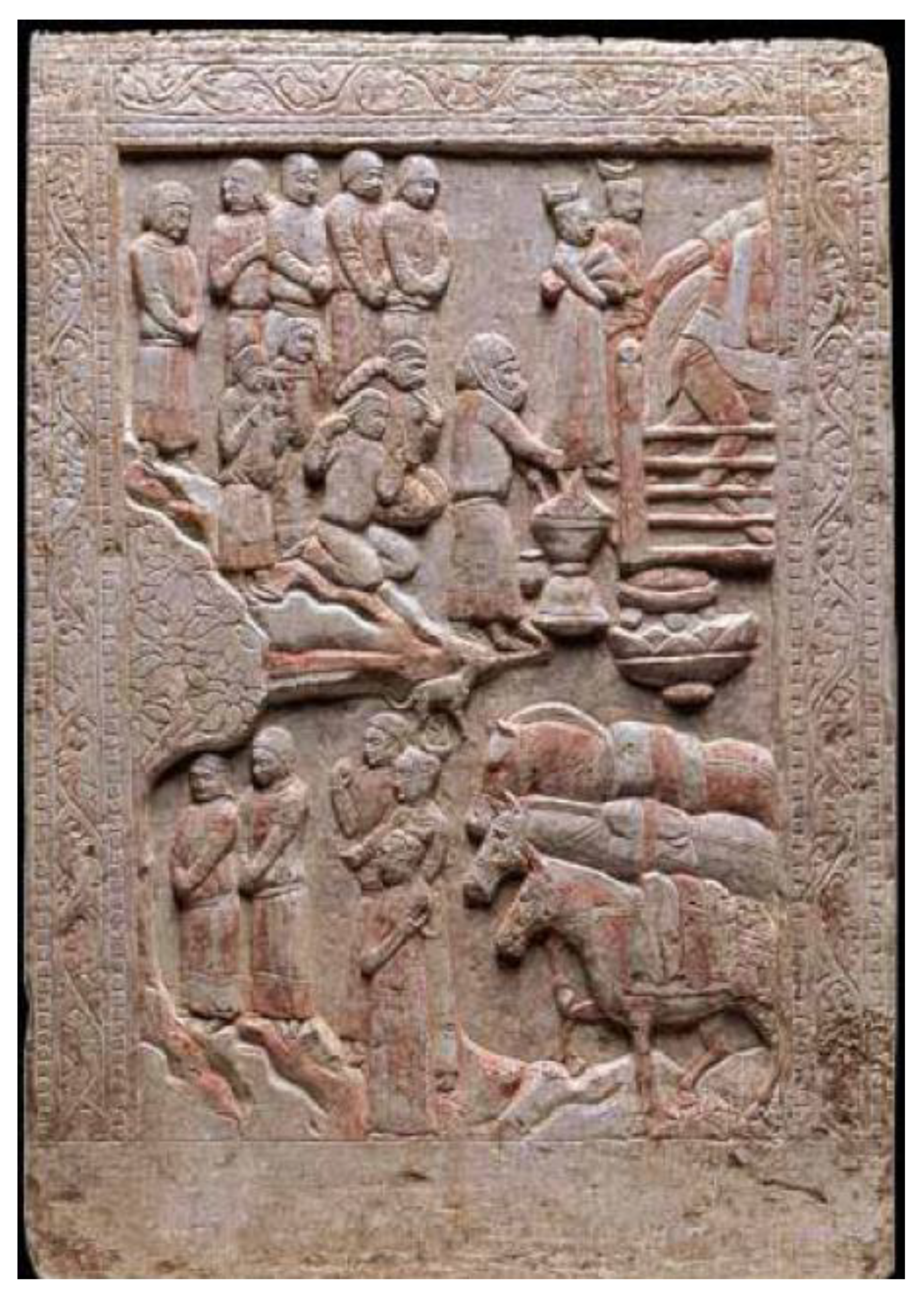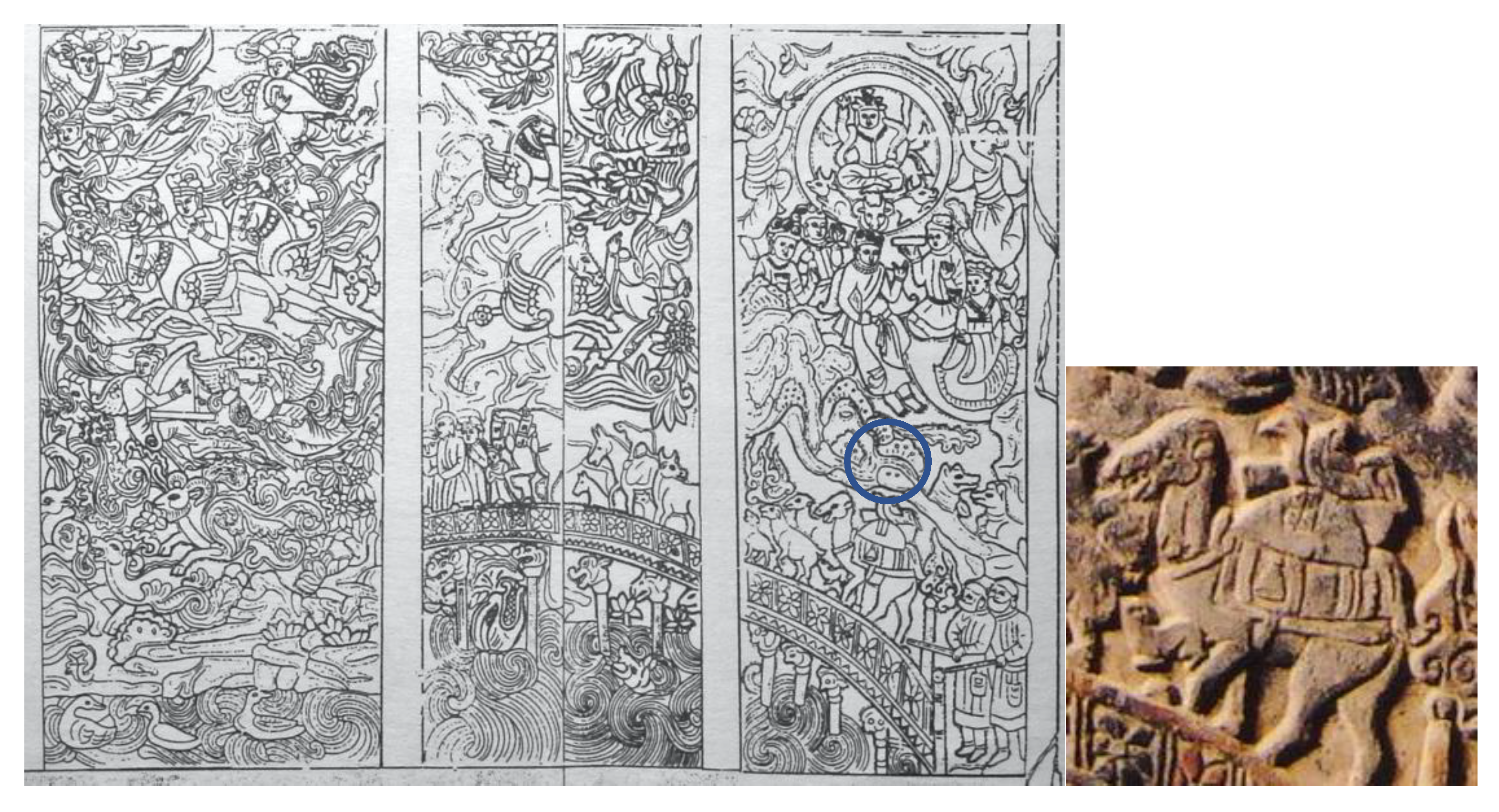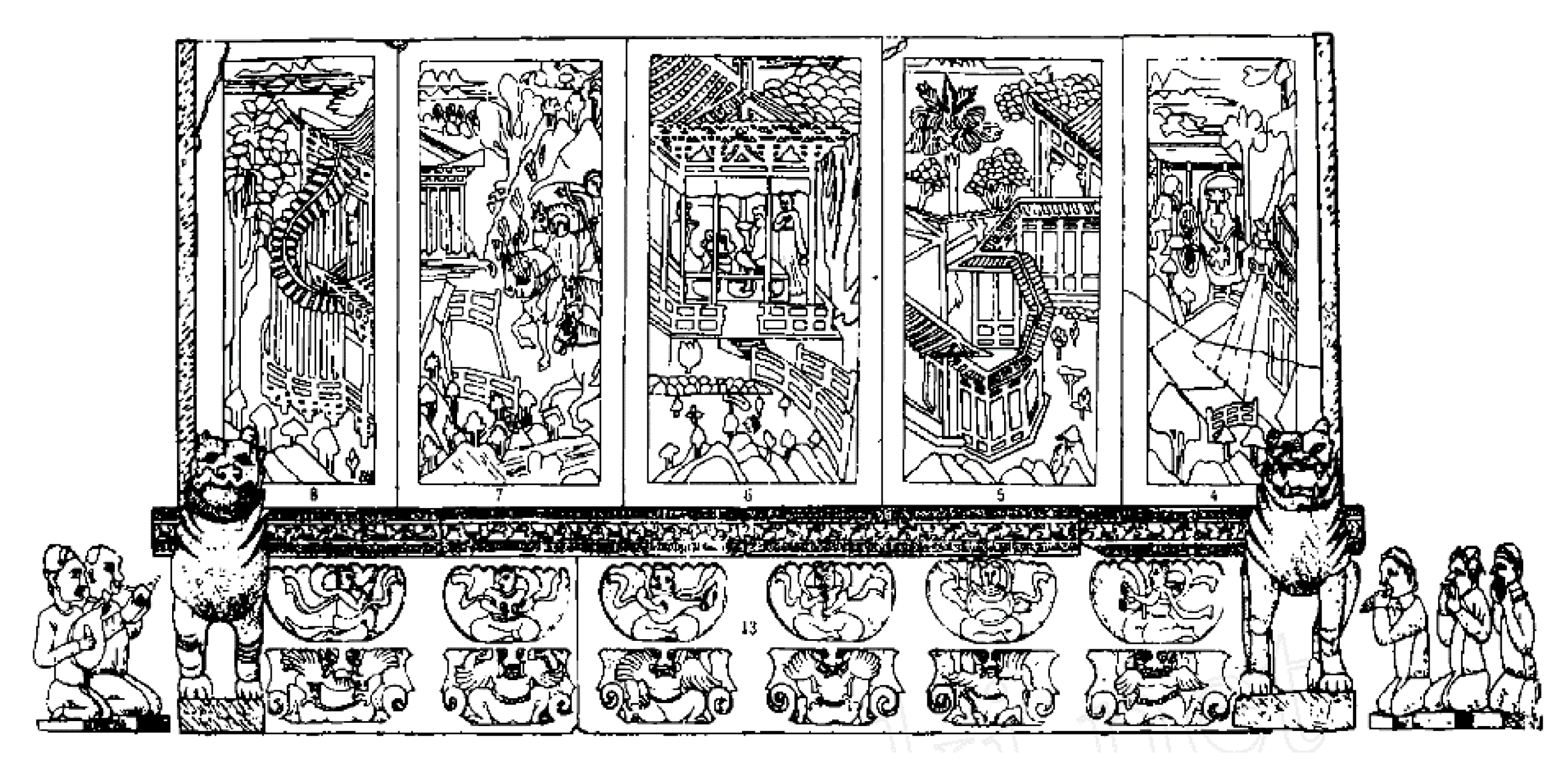1. Introduction
The astounding Sino-Sogdian tomb of Shi Jun史君 (494–579)
1, or Wirkak in Sogdian, was discovered and excavated during the summer of 2003 on the outskirts of Chang’an (modern-day Xi’an), once the capital of the Northern Zhou dynasty (557–581 CE) (
Figure 1 and
Figure 2).
2 The tomb’s sarcophagus, fashioned like a house, was one of the most significant Silk Road finds ever discovered (
Xu 2021, p. 145). A house-shaped sarcophagus symbolizes some sort of ethnic connection. During the fifth and sixth centuries, house-shaped sarcophagi were not used by the indigenous Chinese who had lived in central and southern China for generations, but were preferred by the Xianbei, Sogdian, and other people of Chinese or non-Chinese ancestry who had immigrated to northern China from the West (
Wu 2002, p. 40). Sogdians adopted this kind of house-shaped sarcophagus in their quest for a true “Chinese” emblem of posthumous immortality, since the house-shaped sarcophagus originated in Sichuan during the Han period (206 BCE–220 CE) (
Wu 2002, p. 34). The psychological reason for their adaption of an ancient regional burial construction may have been that, in their quest for a real “Chinese” emblem of posthumous immortality, they accepted this mortuary structure because it was linked to a prevalent Daoist tradition in the north (
Wu 2002, p. 40).
3The Shi Jun sarcophagus’s portrayal of a couple’s life is unparalleled and cannot be seen in any other work of Chinese art; it allows us to picture a society previously only accessible through written sources, providing us with new information about the Sogdians in Northern Zhou China. In ancient times, the Sogdians were an Eastern Iranian people who originated in what is now the countries of Uzbekistan and Tajikistan. Sogdians were the primary traders and migrants between the East and the West for most of the first millennium CE. Prior to the Arab conquest in the 7th century, the majority of Sogdians dwelt in a network of semi-independent communities in Central Asia, where they practiced Zoroastrianism, Mazdaism, and other religions. Nonetheless, masses of Sogdians fled their homeland and lived in key towns along the pathways leading to China’s mainland from the third to the eighth centuries CE (
Xu 2021, pp. 146–47).
The tomb occupant Shi Jun was born in the state of Shi, which is now known as Kesh in today’s Uzbekistan. After moving to Liangzhou, Gansu Province, he assumed the title
sabao薩保, a Chinese translation of the Sogdian term
s′rtp′w, meaning “caravan leader”, but subsequently rose to the position of administrator in charge of the international and foreign religious issues of Central Asian immigrants who had arrived in China at the time. Shi Jun’s wife Kang Shi (d. 580 CE), also known as Wiyusi, was born in Xi’ning, Qinghai province, and her ancestors were from the Samarkand. The couple married in Xi’ning but subsequently moved to, and eventually died, in Chang’an. Shi Jun’s tomb was built in the eastern suburbs of Chang’an after his wife died (
Xu 2021, p. 145).
The Shi Jun sarcophagus highlighted a patchwork of religious beliefs among migratory peoples in premodern Eurasian Europe. Étienne de La Vaissière, Frantz Grenet, Albert E. Dien, and Judith Lerner have written extensively about the iconography of the sarcophagus, and it is believed that Zoroastrianism and Manichaeism are its main religious influences. (See
Trombert and Vaissière 2005;
Grenet and Riboud 2003;
Grenet et al. 2004;
Dien 2009;
Lerner 1995;
Wertmann et al. 2017;
Grenet 2013). Yet a more coherent and complete description of the entire pictorial sequence of the sarcophagus’s eleven vertical panels, starting from the west wall and moving across the north wall to the east wall, is required (
Figure 3). Other elements, such as the orientation of the corpse and the sarcophagus, which have not yet been studied in the case of this tomb, will also be analyzed here. In most archaeological contexts, directional cosmology was expressed in architectural settings. However, the subject of the orientation or arrangement of the Sogdian tomb has long been neglected. This article, therefore, attempts to explore the ethno-historic or epigraphic sources for a more explicit statement regarding the cosmological influences on Sogdian burial.
When there exists in a culture a coherent and prevailing system of religious beliefs, the elements of that system are likely to be invoked in explanations of that culture’s religious iconography. However, there was no dominant religion associated with Sino-Sogdian burials. For a Sino-Sogdian tomb such as Shi Jun’s, the explanation of the iconography of its sarcophagus is not therefore based on a single orthodox religion but can likely be accounted for by more syncretistic, indigenous and localized folklore, tales, and hymns combined with various religious beliefs, because social order and the religious order of a society are often mutually reinforcing (
Kyriakidis 2007, p. 112).
2. Manichaeism and Zoroastrianism among the Sogdians
The study of Manichaeism and Zoroastrianism among the Sogdians is central to understanding their cosmogony; their account of the creation of the cosmos; and their eschatology, the description of its final events and the framework within which humans can understand their own existence (
Klimkeit 1993, p. 35).
In the course of the sixth century, the Manichaeans in the East began to challenge the authority of the Archegos in Babylonia, which led to a schism. It was the Greek victories that led to the dispersion of Sogdians, who soon established a string of communities from Merv to the western frontier of China, with the Manichaeans in the East called themselves “The True Ones”. At the time when Mar Ammo and other Manichaean missionaries were active in Transoxania, Sogdian traders had already established a reputation as the principal transmitters of goods, especially silk, between China and the lands to the west of the Pamirs. Whereas the merchants in Sasanian Persia were clustered together with other commoners to form the lowest of the four social classes, in Sogdiana they formed a class of their own, in between the aristocracy and the laborers, according to their real importance. The Sogdians, with contacts on both sides of the Pamirs, were the perfect intermediaries in the flow of commodities and ideas between civilizations.
4In the sixth century, Sogdiana was associated with the Hephtalites or White Huns, who in 484 CE annihilated an opposing Persian army led by Peroz.
5 As a nomadic tribe of central Asia, the Sogdians had a mixture of faiths and languages. They were the transporters of culture and religion as well as of merchandise. The Turks often sent tributes in the form of horses to the Chinese court, which were acquired by the Sogdians, who came into contact with the Manichaean communities in Tocharistan and Bactria. So dominant were the merchants of Sogdian origin that the Sogdian language
6 became the
lingua franca of the Silk Road and was used by the Manichaeans, alongside Parthian and Middle Persian, for their religious literature in the course of the sixth and seventh centuries.
7Sixth-century Sogdians were also heavily affiliated with Zoroastrianism and considered themselves Zoroastrians. In this regard, Sogdian emigrants living in the colonies situated along the Silk Road would have adhered to the religious practices of their homeland. However, in contrast to their western neighbors (i.e., Sasanian Iran), the Sogdians did not practice Zoroastrianism as an organized state religion. In their everyday life, they prayed to gods other than Ahura Mazda, the supreme deity of the Zoroastrian faith, to seek more immediate protection within a certain community. In China, little evidence of pure Zoroastrian postmortem practices have survived. For instance, the Zoroastrian denunciation of inhumation, due to a fear of polluting the earth, led to the airing of the corpse and the ensuing relocation of its bones in clay or stone ossuaries, but such rituals and ossuaries have never been found in China (although corpses may have been exposed prior to burial). Instead, elaborately painted and gilded stone funerary couches and painstakingly carved sarcophagi have been found.
8In addition to Zoroastrianism and Manichaeism, the religions followed in Sogdiana were Hinduism, Christianity, and Judaism (
Marshak and Raspopova 1997). Missionaries of religions other than Zoroastrianism attained far greater success among the Sogdians living in Semirchye, Xinjiang, and Gansu. During the fifth, sixth, and seventh centuries, the Sogdians expanded the iconography of their gods, both Zoroastrian and non-Zoroastrian, which explains the comprehensive iconography of Shi Jun’s sarcophagus (
Marshak and Grenet 1998).
3. Three Deities
Images, symbols, and reliquaries used in a ritualistic and religious context are some of the most compelling instruments for the delivery of religious messages and for asserting social position. Shi Jun’s tomb provides us with unparalleled insight into the practices of religious and everyday life among the leaders of the Sogdian community in the sixth-century China. The tomb inscription describes Shi Jun’s birth into a distinguished family and the voyage of that Sogdian family from Central Asia to China’s capital. The epitaph, on the other hand, provides no details on Shi Jun and his wife’s spiritual experiences and lacks religious substance in general.
When it comes to understanding burial content, writing is not always more authoritative than graphic depictions such as sarcophagi illustrations. More extraordinary than the epitaph text in Shi Jun’s tomb is the sarcophagus’s exterior, which is engraved with an uninterrupted series of story-like reliefs. These images are indicative of the deceased’s Silk Road journey and other events in his life. Eleven vertical panels, commencing on the west wall, proceeding along the north wall, and culminating on the east wall, are depicted on the sarcophagus’s exterior, which will be referred to as W, N, and E. These panels depict both religious motifs, such as divine figures, as well as secular activities such as feasting.
Among the religious motifs, three divine figures are depicted. The first deity discussed here is shown in the first section on W1. Grenet has identified this figure as Mani, the “Buddha of Light” (
Figure 4,
Figure 5 and
Figure 6) (
Grenet 2013). The deity’s gesture has been identified not as a Buddhist mudra but as a specific gesture with the forefinger and the little finger extended, which in Iranian contexts appears to express the idea of victory. However, the identification of the figure as “victory” Mani is somewhat debatable. Rather, this gesture can be identified as the ardhapataka-mudra, an iconographic body pose specifically seen in images of Hindu deities.
Other scholars have identified this deity as Laozi, Ahura Mazda, or the Zoroastrian savior Sošans (
Xu 2021, p. 153). Jin Xu, undeterred by the sacred figure’s thick beard, believes this image is of Buddha’s
jataka story and ties it to his argument that the design of the house-shaped sarcophagus was influenced by iconography from Prince Siddhartha’s life (
Xu 2021, pp. 150–52). Nonetheless, because the figure wears a pointed mustache and appears in a non-Buddhist context, I am more inclined to support a Manichaean rather than a Buddhist identification for the deity. Moreover, the three praying men on W1 are wearing high, threefold caps, unlike those worn by Zoroastrian or Buddhist priests but identical to those of the Manichaean priests depicted in illuminated books from Gaochang, Turfan (
Figure 7). The reason why this Mani on panel W1 has a Buddhist appearance was due, partly, to the eastward expansion of Manichaeism, during which Buddhist features were assimilated into Manichaeism.
9 Yet the Sogdians were rarely well disposed to Buddhism itself, and the Buddhist faith never flourished among the Sogdians (
Grenet 1994, p. 47).
The most mysterious of the three deities or figures is shown on the upper register of the final section of the north wall (
Figure 8). He has never been clearly identified. Étienne de la Vaissière identified him as Mani because Mani is sometimes called the great ascetic (
Vaissière 2005, p. 362). Grenet identified him as an Indian ascetic meditating in a cave and so considers that Zoroastrianism is thus excluded from the picture, as asceticism did not form part of its doctrine (
Grenet et al. 2004). It is true that Zoroastrianism is remarkable in rejecting any form of asceticism, including celibacy and fasting, to torment the body or to repudiate normal pleasures. Cheerfulness is an admirable form of courage; and, in this life-affirming religion, both optimism and courage are cherished virtues, which help to maintain well-being and so generate salvation for society as well as the individual (
Godrej and Mistree 2002, p. 26). However, is this figure an Indian aesthetic? Gulácsi and BeDuhn hold that N5 is a Komāyaputta Jātaka scene. Fairy tales of Indian provenance, as well as animal fables and stories about wise judges, were known in Sogdian folklore as a result of direct contact with Indian merchants on the Silk Road (
Gulácsi and BeDuhn 2012, p. 17). Here, an iconographic representation may be crucial, but it is precisely on this point that interpretations may differ. Moreover, Zoroastrianism and Manichaeism are neither altogether incompatible nor mutually exclusive in this sarcophagus. Through concentrating on both religions, we may raise questions about the mechanisms by which cultural traditions, including art, are replicated and comprehended. It provides an interpretive space in which artworks and images participate actively in the development and transformation of civilizations, rather than just representing them.
The third deity is shown in the upper register of the first section on the east wall (
Figure 9). The scene is presided over by a god whose iconographic characteristics—bulls and a trident—are those of Shiva Maheshvara. However, the god would usually have three heads instead of the one depicted here. Individual cultural identities are not static, much less pure; in Sogdiana, the iconographic type of Shiva Maheshvara was transferred to the Iranian god Vayu, an atmospheric deity (
Grenet 2007, p. 474). Some coins of the Kushan kings Kanishka II and Vasudeva I also employ the identifying features of one human head, one bull, and a trident on the reverse, along with the inscription OHϷO (oesho) in modified Greek script (
Figure 10 and
Figure 11).
Oesho was a deity who was often identified with Shiva, and whose name is pronounced in the same way as Shiva in the Bactrian language of the Kushans. Nevertheless, recent research suggests that Oesho was the Zoroastrian Vayu with the attributes of Shiva. This explains why Vayu was indeed imagined as having one head. Although it is the Zoroastrian deity Vayu who resides in the topmost register, below him are the Manichaean Virgins of Light. The leading winged female figure was identified as Manichaean Daēnā, accompanied by her two companions who bear a flower and a flag. Holding the tip of a bud-like flower suggests the gesture of the Manichaean Virgin of Light releasing up to heaven the living soul in the particles of light within the flower she holds (
Gyselen et al. 2011, p. 63).
4. Three Parts of a Day
The most enigmatic parts of the sequence are the inseparability of the religious and everyday spheres and the specific placement of the three, deity-like figures in the west, north, and east walls, respectively. In this regard, a wonderful discovery is a Sogdian tale of Manichaeism, titled “To divide the day into three parts”:
And again the Apostle, the Lord Mar Mani spoke thus: The wise and soul-loving person should divide the day into three parts.
The first (part should be devoted) to the service of kings and lords so that they be well content, that their majesty be not infringed, and that they do not start quarrelling and scheming. The second to the pursuit of worldly affairs, to tilling and sowing, to allotments and hereditaments, to buying and selling, so that the house be maintained, that wife and children be not in distress, and that kinsmen, friends, and well-wishers can be well served…
The third part of the day, of course, was to be devoted to the care of the Manichaean monks.
This text is crucial, for it agrees with the pictorial sequence in Shi Jun’s sarcophagus. The connection between Mani and feasting in the first section of the west wall (W1) may well take place in the context of this tale (
Figure 4). After first praying to the “lord” Mani, who will then be satisfied that “their majesty be not infringed, and that they do not start quarrelling and scheming”, they pursue “worldly affairs” during the second part of the day. Moreover, the key elements “house”, “wife and children”, “kinsmen”, and “friends”, mentioned in the tale, all appear on the sarcophagus. It should also be mentioned that panel W1 is divided into two parts, with meat-eating animals on the left and herbivores on the right (
Figure 4). Worshiping the lord Mani during the first part of the day is intended to stop “quarrelling and scheming”, which is a major tenet of Manichaeism: namely, respect for living creatures and abstinence from eating meat. The feasting, hunting, and drinking scenario has been identified by Albert Dien as autobiographical (
Figure 12) (
Dien 2009).
Feasting and drinking are common motifs in tomb art. Although it is easy to imagine that such feasting would have had religious connotations, since concerns with death and the world beyond are often situated within religious belief systems, it is not necessary to always consider them in that light. To take an example from contemporary Chinese and Western society, it is common after a funeral for the relatives of the deceased to offer alcoholic refreshment to the attending mourners. This may certainly be termed a ritual. Often, those who do not habitually drink alcohol will do so on such an occasion, yet there is no suggestion that this formalized drinking has a religious connotation, even if the funeral itself may have one.
The three-parts-of-the-day tale also explains the top figure in the last section of the north wall (
Figure 8). Rather than being an Indian ascetic, he should be identified as the Manichean monk to whom devotion is paid during the last part of the day. The Manichaeans in Central Asia made use of the life of the Buddha as a teaching aid, especially on ascetical matters. It should be noted that the images relating to the three parts of the day start at the beginning of the west wall and run only to the end of the north wall. Starting with Vayu, in the east wall (
Figure 13), is an entirely new interpretative system which is no longer concerned with the mundane but rather with the afterlife: in other words, the postmortem judgment of the tomb’s occupant.
5. Hymns and Iconography
How to identify and understand burial iconography is one of the major issues facing studies of religion in the archaeological record. The problem is compounded because the same artifact types may function in both domestic and ritual contexts. Most of the iconography of Shi Jun’s sarcophagus has been rigorously discussed, yet some remains unexplored. This article delves deeper into those iconographic aspects by utilizing Zoroastrian hymns.
W1 embodies various subjects, first among which is a juxtaposition of God and humans, of violence and inner peace, of heaven and earth. The hymn below (Yasht.8.5) attests to this pictorial depiction:
We sacrifice to the star Tishtriya, wealthy and munificent,
whom sheep and cattle recall
(when) faced with violent men,
(when) faced with lying magicians:
When will he rise for us
Tishtriya, wealthy (and) munificent?
When will new springs of water flow
deeper than (the length of) a horse’s (legs)?
On account of his wealth and munificence…
Thus, we sacrifice to the male and female deities…
Especially noteworthy are the “violent men” and “springs of water flow”, which are shown across the lower part of the panel. Manichaeism taught an elaborate cosmology, depicting the conflict between a divine world of light and a corrupted one of darkness. Another hymn that attests to W1 is Yasht.5.89, in which sheep form the main subject:
O upright, Orderly Spitama-son!
Ahura Mazdâ set you in (your) place
as the ratu of the bony world of the living.
Ahura Mazdâ set me in (my) place
as the protectress of the entire time span of the Orderly one.
By my wealth and munificence
sheep and cattle
roam over the earth
as well as two-footed humans.
And so shall I protect
all those good things set in place by Ahura Mazdâ whose
seed is from/according to Order
like a shepherd (his) sheep.
The Zoroastrian hymns that describe Vayu can be understood both literally and metaphorically in regard to the east wall. Below are cited several hymns describing Vayu that contain the elements which match the iconography in the east wall so well. In Vayu (Pahlavi Wây):
This is the god of the wind that blows through the intermediate space and the intermediate space itself, through which the breath soul (urwan) and vision-soul (daênâ) of the dead must travel in order to reach the Bridge of the Accountant.
Vayu is therefore associated with inflexible destiny and has both a good and a bad or stern side.
The stern side of Vayu is expressed in several verses of the Aogemadaêca.
As can be seen from the hymn, the soul of the deceased must travel in order to reach the bridge; Vayu is affiliated with adamant fate and has both a favorable and an evil side. In other words, Vayu judges the soul. On the east wall (
Figure 13), revitalization is the center of the concern (Yasna.0.9). According to the Avesta, the primary collection of religious texts of Zoroastrianism, Ahura Mazdâ was not the only one to “set things in place”. Already in the Young Avesta we find the idea of a binary “conception” by the good, Life-giving Spirit and the bad Spirit, notably in the hymns to the pre-souls, to Vayu, and to Sraosha:
Come to my help, O Mazdâ,
(for the help of?) the well-fashioned, well-shaped force,
the obstruction-smashing strength set in place by Ahura
Mazdâ,
the victorious superiority,—
of peace with good pastures,
of Vayu, whose work is above, set beyond the other Creations,—
this of yours, O Vayu,
which you have of the Life-giving Spirit,—
of the Firmament, which has its own law,
of boundless Time,
of Time, which long has its own law.
Order is the best good … Here, Vayu’s attribute as “life-giving spirit” is highlighted. Revitalization movements are most frequently generated by societies undergoing a high degree of internal stress, usually due to contact or domination by a culturally different society such as the migrating Sogdian, whose lives and businesses were both constantly at the disposal of other ethnic groups. In other hymns, Vayu’s location on the top register is explained (Videvdad.19.13):
Then Ahura Mazdâ said:
Call hither you, O Zarathustra, the good daênâ
of those who sacrifice to Ahura Mazdâ!
Call hither you, O Zarathustra—
may the Life-giving Immortals come down
upon the earth with its seven continents!
Call hither you, O Zarathustra, the Firmament
set in place by itself,
unlimited Time, (and) Vayu whose work is above.
Call hither you, O Zarathustra, the brave wind
set in place by Ahura Mazdâ
(and) the Life-giving beautiful daughter of Ahura Mazdâ
Most of the iconography here has been identified and interpreted. The dog, an animal that appears numerous times on the sarcophagus, was essential to the funerary ritual. The ritual involving the dog is called
sagdīd (the viewing by the dog) and is conducted three times during the process of an inhumation. The dog brought to cast its extra-sensory eyes is usually a special one, with two identical marks (seen as another set of eyes) above its actual eyes. This is said to give it the added strength to ward off
nasu (the female Zoroastrian demon of corpse matter) and instinctively detect any form of life in the corpse (
Godrej and Mistree 2002, p. 361). The dog was regarded as beneficent and righteous, and its gaze was believed to drive away evil (
Lerner 2011, p. 19). However, unlike the Miho panel (
Figure 14), it is hard to say that the appearance of the dog here definitely relates to the Zoroastrian funeral rite, although some hints that is related to that rite can be gained from the context.
First, no conspicuous funeral rite is pictured in either the west or east walls; secondly, the dogs appear rather mundanely in the west wall as involved in domestic and hunting activities. The bejeweled trees, the crown, and the clothing have been widely discussed by Grenet and Ribound (
Grenet and Riboud 2003, pp. 133–43).
The Zoroastrian hymn provides a more detailed explanation of the iconography of the water, a bird, and Vayu (Videvdad.5.8):
O Orderly creator…
Does water kill a man?
Then Ahura Mazdâ said:
Water does not kill a man.
The Dismemberer binds him.
Vayu leads him bound.
The water carries him up,
the water carries him down.
The water leaves him.
Then the birds nibble at him.
There then he goes forth,
distributed then he goes down.
The bird depicted above the camel (
Figure 15) appears to be nibbling, as if at the invisible soul, while the swirling water beneath the bridge is shown in turbulent motion, as if it is carrying the soul up and down.
In the subsequent hymn, fire is mentioned:
O Orderly creator…
Does fire kill a man?
Then Ahura Mazdâ said:
Fire does not kill a man.
Astô-vidhôtu binds him.
Vayu leads him bound.
The fire burns up the bones and the life breath.
there then he goes forth…
Here, aside from the mention of fire, the hymn also indicates the function of Vayu and the aftermath of his action, in which the soul goes forth. According to Grenet, the flames shown in two places over the initial section of the bridge are those which help the soul to cross in the darkness (
Figure 16) (
Grenet et al. 2004, p. 279).
One thing that confuses the present author is the
Čhinwad bridge of Zoroastrian postmortem judgment on the east wall. It looks as if it is broken at the left end, and the depiction of continuous movement over it is suddenly frozen. However, a reference to the depiction of this bridge in other Sogdian tombs (An Jia安伽 and Tianshui天水) reveals its rationality. The imagery features a different kind of perspective from the Chinese one, which creates more depth (
Figure 17). The figures in E1 are clearly larger than those in E2, and, when we reach the last panel, the scene has been entirely altered (
Figure 13). The lower register of hell and earth has been eliminated and the deceased has already arrived in heaven, riding the winged horse that first appears on the middle panel.
6. The Orientation of the Tomb and the Body
Those scholars who investigate spatial patterning identify cases in which the built environment tends to employ some level of pivotal orientation, then argue assuredly that the architecture, metropolis, reservoir, and tomb under study constitute a cosmogram (
Smith 2005, p. 220).
Given the significance of directional cosmology in Han culture, however, it seems likely that cosmology may have influenced the burial symbolism and perhaps even the design of architecture and the metropolis. In the absence of the kind of clear and direct evidence available for tombs such as those of An Jia, Kang Ye康業, and Shi Jun, this question will be approached cautiously here, with reference and comparison to funerary structures and practices in other cultures and religions, such as Han China, Mesoamerica, and Egypt, as well as Christianity and Islam.
Han tombs primarily have a north-south orientation. Archaeologists believe that the most critical features of orientation are the direction of the head and the direction in which the body faces (
Ucko 1969, p. 271). In Han times, sarcophagus design typically employed the set of Four Directional Animals or its variations, because of its strong cosmographic associations. Since the north is considered the region of yin and death, and the south is associated with yang, birth and rebirth, the coffin’s smaller end designates the north, and often features the Dark Warrior, while the large end represents the south, and is often occupied by the Vermillion Bird. The corpse’s head is placed at the larger end of the coffin, so that the design creates a scenario in which the deceased’s disembodied spirit flies from north to south: that is, from the small to the larger end of the coffin. In this way, the spirit would be heralded by the Red Bird in front, the Dark Warrior behind, the Green Dragon on the left, and the White Tiger on the right (
McCausland 2003, p. 111).
The ethnographic dissimilarity of people in Northern Zhou led to different ways of orientating a body from those of the Han Dynasty. The primacy of the east-west direction in the arrangement of Shi Jun’s tomb may derive from the movement of celestial objects, such as the paths of the sun, moon, Venus, and the Pleiades star cluster, and other planets or constellations.
10Ethnographers think that the deceased’s body was often oriented in the direction in which the soul was traveling, a route that connects both the deceased’s geographical location and the dwelling site of the person’s ancestors (
Perry 1914, pp. 282–86). This exercise brings to mind a Christian practice, in which the head is situated to the west and the feet to the east so that, in line with folklore to a certain degree, the ascending body faces east at the time of the Last Judgment. Ucko notes that this type of orientation is also used to distinguish a certain class of people in Christian practice (a religion embraced by some Sogdians), as a Roman Catholic priest/bishop is not only buried in a distinctively restricted section of the necropolis but is also laid with his feet to the west, facing his congregation in death as well as in life (
Ucko 1969, p. 272). (See (
Dearmer 1902, p. 42); see also (
Polson 1953, p. 229)).
Additionally, Ucko observed that the direction of the deceased’s head and feet is critical for orientation (
Ucko 1969, p. 272). At Armant in Egypt, archaeologists believe either that the orientations of north-south and east-west were a result of the predynastic Egyptians attempting to align themselves with the sun and moon, employing the river as a guide because they considered it “as always running north and getting muddled where it changed direction”, or that the funeral was “unrelated to the sun and intended to be parallel to the river, the bodies lying in the direction of the flow of the water”(
Mond 1937, p. 10). Such a relationship with a river, along which the soul was believed to wander to the territory of the deceased, is a convention known from certain Indonesian tribes (
Perry 1914, p. 282). It is also important to consider the direction the body faces in relation to a specific geographic location, since this may be the deciding factor for positioning the deceased in some cultures. For example, in Muslin burial practice, the corpse is oriented toward the especially significant city of Mecca.
It is noteworthy that Shi Jun’s east-west oriented sarcophagus is not a unique case among Sogdians in Northern Zhou China. The tombs of An Jia安伽, Kang Ye康業, and even Yu Hong虞弘 feature the same spatial construction (
Figure 18 and
Figure 19). It is tempting to generalize or problematize the east-west orientation of the Sino-Sogdian burials based on the religious belief systems it might embody.
7. Conclusions
The interpretation that I present here is neither final nor all-encompassing. The commission of a tomb is a social act and hence presumes that more than one consciousness is involved in its making. The social order and the religious order of society are often mutually reinforcing. In response to the pictorial sequence of Shi Jun’s tomb, we inescapably manifest the deviation in value that is generated by the struggles of the social, political, and economical life of the deceased.
11 The sarcophagus, the east-west orientation, the placement of the bodies, and the decoration of the tomb suggest cosmological interpretations for Sogdian entombment in sixth-century China and reflect a rather eclectic and heterogeneous cultural influence.
Although a mixed approach was adopted in the construction of Shi Jun’s tomb, it was never arbitrary. The nonarbitrary nature of the relationship between the source and target domains provides us with some degree of insight into the worldview of the Sogdians. The study of the tomb material’s metaphors reveals that different worldviews structured and governed these people. They were cultural carriers, as well as cultural outsiders.
Hymns and tales are necessary to help us decipher the tomb’s pictorial sequence, because our interpretation of the archaeological record cannot rely solely on our knowledge of the religious beliefs, orthodox or otherwise, of the Sogdians. Religion, although assisting cohesion, is epiphenomenal. There is often little direct reflection of a single religion in an individual’s life. In fact, even in the Sogdian’s homeland, no single polity was adopted. Shi Jun’s tomb in China, a revelation of his life and the life of his family, is even more multifactorial in nature.
The multifaceted iconography of Shi Jun’s tomb points to not only the social conventions of his family but also the social acceptance they had achieved. The tomb’s layout and iconography were informed by Han tradition, Zoroastrian ritual, and Manichaean tales, indicating that Shi Jun and his family wished to convey to themselves and others that they accepted and respected those different cultural constructs. The house-shaped sarcophagus itself was adopted from a Chinese tradition invented in Sichuan during the Han dynasty as a sign of seeking immortality according to the Han dynasty and Northern Wei’s prevailing religion of Daoism. The front of the tomb’s entry door faces south, which according to Zoroastrian belief is the direction of Paradise. Although the Sogdian writing above the door is not explicitly religious, it refers to the two deceased achieving “Best Existence”, or Paradise, in Zoroastrianism (
Gulácsi and BeDuhn 2012, p. 3). While the majority of the iconographic motifs are in line with Zoroastrianism, some are associated with Manichaeism, evidence for the personal religious syncretism of Shi Jun. The tomb implies an open acceptance of the traditions set down by the Sogdians in China. Acceptance, in turn, brings with it the obligations entailed by the conventions and duties as
sabao that Shi Jun was expected to adhere to and carry out. From this perspective, his tomb is a successful manifestation of the establishment and management of many aspects of the social order. Ritual, burial, and tomb decoration solemnize and affirm his family’s social role and religious affiliation.
